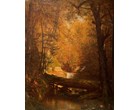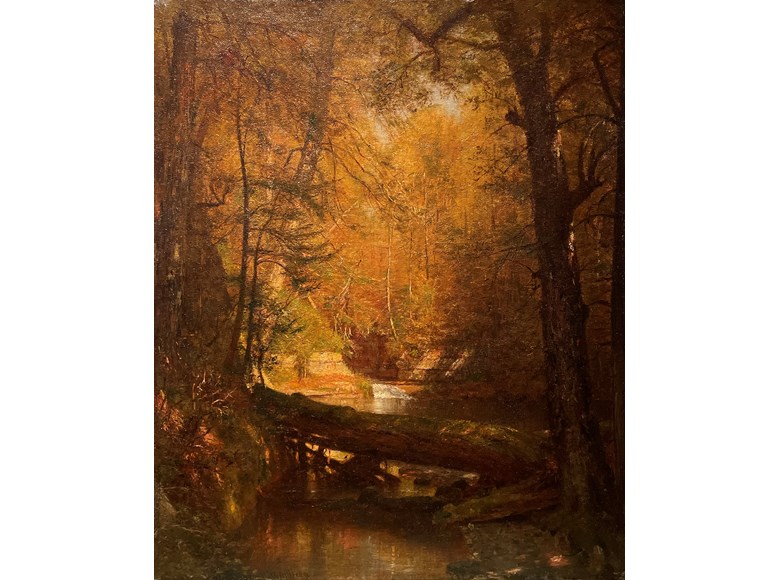 BACK TO GALLERY
BACK TO GALLERY
Avery Galleries
Worthington Whittredge
Study for "The Trout Pool"
Signed lower left: W. Whittredge
15 3/8 x 12 3/4 inches (39.1 x 32.4 cm)
description
Born in Ohio, Worthington Thomas Whittredge began his career as a sign and portrait painter in Cincinnati, where he attracted the attention of local patrons whose support enabled him to travel abroad. After a decade of study in Europe, he returned to the United States in 1859, settling in New York City to pursue landscape painting. He rented a studio in the new Tenth Street Studio Building, where Frederick Church, Sanford Gifford, and other leading painters were already in residence. Whittredge managed to have four of his European paintings accepted for the National Academy of Design’s exhibition in the spring of 1860, but he realized that to succeed he would need to produce something new and which might claim to be inspired by his home surroundings. He had recognized that the success of the Hudson River School was due largely to the way its native subject matter gave pictorial expression to strong currents of American nationalism and pride. And he knew, too, that his own art was still so much under the spell of Europe that he needed an aesthetic jolt of fresh inspiration. So, like Thomas Cole thirty-five years before him, Whittredge went to the first available outdoor place he could find, the Catskills.
The scenery Whittredge found in the Catskills surprised him greatly: “But how different was the scene before me from anything I had been looking at for many years! The forest was a mass of decaying logs and tangled brushwood, no peasants to pick up every vestige of fallen sticks to burn in their miserable huts, no well-ordered forests, nothing but the primitive woods with their solemn silence reigning everywhere. I think I can say that I was not the first or by any means the only painter of our country who has returned after a long visit abroad and not encountered the same difficulties in tackling home subjects.” Gradually, Whittredge came to term with his new subject, while still maintaining a firm grasp on the painting techniques he had learned in Europe. He started sending American scenes to the Academy exhibitions and received high praise. His style was at once meticulous in its delineation of the intricate forms of the forest and remarkably assured in its fluent brushwork. Whittredge’s years of study in Europe (especially in Dusseldorf) had taught him that the actual appearance of nature could be portrayed through means other than the literal, precise brushwork often favored by his colleagues. He knew that sometimes more could be achieved by suggesting, rather than simply mimicking, the facts of external reality. Whittredge had managed to bring a new vitality to the American landscape. None of his contemporaries would be so successful in melding the sophisticated lessons of European painting with the nationalist aspiration and religious associations that had become endowed in the American landscape itself.
This work is a study for the larger canvas of the same title at The Metropolitan Museum of Art. Likely a landscape in the Catskills, the painting reveals the influence of Asher B. Durand; however, Whittredge used a masterful blend of light and shadow, detail and painterliness to emphasize nature's expressive qualities, in particular what made the American landscape extraordinary.
The scenery Whittredge found in the Catskills surprised him greatly: “But how different was the scene before me from anything I had been looking at for many years! The forest was a mass of decaying logs and tangled brushwood, no peasants to pick up every vestige of fallen sticks to burn in their miserable huts, no well-ordered forests, nothing but the primitive woods with their solemn silence reigning everywhere. I think I can say that I was not the first or by any means the only painter of our country who has returned after a long visit abroad and not encountered the same difficulties in tackling home subjects.” Gradually, Whittredge came to term with his new subject, while still maintaining a firm grasp on the painting techniques he had learned in Europe. He started sending American scenes to the Academy exhibitions and received high praise. His style was at once meticulous in its delineation of the intricate forms of the forest and remarkably assured in its fluent brushwork. Whittredge’s years of study in Europe (especially in Dusseldorf) had taught him that the actual appearance of nature could be portrayed through means other than the literal, precise brushwork often favored by his colleagues. He knew that sometimes more could be achieved by suggesting, rather than simply mimicking, the facts of external reality. Whittredge had managed to bring a new vitality to the American landscape. None of his contemporaries would be so successful in melding the sophisticated lessons of European painting with the nationalist aspiration and religious associations that had become endowed in the American landscape itself.
This work is a study for the larger canvas of the same title at The Metropolitan Museum of Art. Likely a landscape in the Catskills, the painting reveals the influence of Asher B. Durand; however, Whittredge used a masterful blend of light and shadow, detail and painterliness to emphasize nature's expressive qualities, in particular what made the American landscape extraordinary.






 SEND AN EMAIL
SEND AN EMAIL
 (610) 896-0680
(610) 896-0680